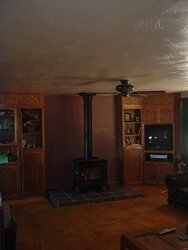I used to have a vermont castings propane gas stove. The former owners put a ceiling fan in close proximity above that gas burner, but I sold that stove to buy my Englander 13NCH. It seems now that the extreme ends of the blades will not have the 18' clearage from the wood stovepipe(24ga). They will and they won't. Let me explain... If I turn off the fan and one of the blades comes to a stop in the wrong place it will only be 9-10" away from the stove pipe. I realize that a ceiling fan is probably better than a stove mounted fan, so I considered moving it, but after looking at the electricals in the ceiling that the former owner did...it was pretty scary. Plus my attic is only a low pitched trussed roof with only crawlable space overhead. Also there is no floor in the attic only trusses and 3/4" strapping in the area I would have to work. I see this fan placement as an unsafe condition. I might prevent this problem using double wall interior pipe from the stove to the HT double wall chimney insulated stuff. Do i have to bite the bullet and do some electrical work which would probably take a whole day. Or buy the englander stove fan or is there any other way to leave the fan where it is and be safe. I guess i dont know the cost of double interior pipe...I'd need maybe 5 feet to the chimney pipe. Should i use the double and save myself the aggravation of moving some hackers electrical job? I' sure if anything kills me in this mobile it will be the wiring before the stove. Sorry about so long a post.
PS his method of having 20 amp circuits was to place 20 amp circuit breakers in the breaker box when he had only 14-2 wiring. To tell you the truth i spent all my buttons on the stove system setup and the wood and i have contacted a professional insulation co to blow 34R insulation into my 1100 square foot home, which has none, for $1000
Thank all members of this forum who have steered me in the right direction.
PS his method of having 20 amp circuits was to place 20 amp circuit breakers in the breaker box when he had only 14-2 wiring. To tell you the truth i spent all my buttons on the stove system setup and the wood and i have contacted a professional insulation co to blow 34R insulation into my 1100 square foot home, which has none, for $1000
Thank all members of this forum who have steered me in the right direction.


